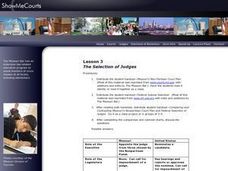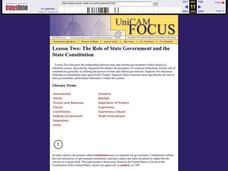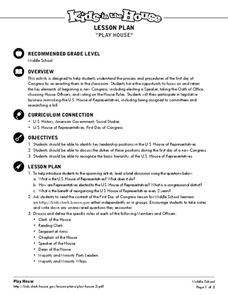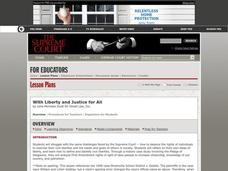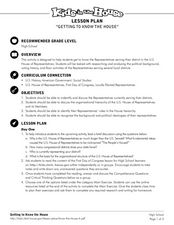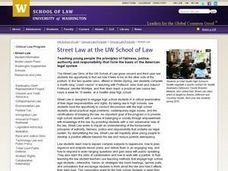Curated OER
The Selection of Judges
Students analyze documents to determine the steps taken in the selection of judges.
C-SPAN
Choice Board: Expressed and Implied Powers
Article 1, Section 8 of the United States Constitution expressly lists powers given to Congress. Over the years, lawmakers have expanded the enumerated powers to include powers implied by the list. To better understand the significance...
Curated OER
Executive Government: Executive Decision Making
Students make executive decisions. In this Social Studies lesson, students explore the concept of executive decisions through a game of chess. Students role play a year-level formal plan and implementation.
Carolina K-12
Principles of the US Constitution
After breaking into groups according to major principles of government (i.e., popular sovereignty, separation of powers, checks and balances, etc.) in the United States, your class members will produce public service announcements...
Curated OER
Branches of Government Graphic
Students explore the three branches of government. They create a graphic diagram to show each branch of government. Students include the qualifications for service and duties of each branch of government in their graphic diagram.
Curated OER
The U. S. Constitution (3)
In this online interactive American history learning exercise, students answer 10 multiple choice questions regarding the early U. S. Constitution. Students may submit their answers to be scored.
Curated OER
Public Trust and Confidence
Students analyze the judiciary system. In this government lesson, students participate in a class discussion on methods to prevent unfairness in the Judicial courts.
Curated OER
Structure and Function of the Federal Government
High schoolers identify the structures of the federal government. They complete a diagram of the structures to show their relationships. They research the names of the major players on the structure, in particular, students own...
Curated OER
The Role of State Government and the State Constitution
Students investigate the relationship between state and national governments. They define the principles of American federalism how the constitution outlines the powers of state and federal government. Lesson focuses on Nebraska...
Curated OER
Play House
Young scholars take a closer look at representative government. In this House of Representatives lesson, students discuss their local representative in Congress and research his or her responsibilities. Young scholars then participate in...
Curated OER
The US Constitution Graphic Organizer
If your learners could use some help understanding the US Constitution, bring in a worksheet that includes reference material and opportunities for paraphrasing. Kids fill in the blanks to reflect their own understanding of the...
Curated OER
Lobbying
Students examine the role of lobbyists in Washington, D.C. In this Legislative Branch lesson, students watch video segments and read excerpts about lobbying. Students write essays that explore the pros and cons of lobbying.
Curated OER
With Liberty and Justice for All
High schoolers examine the role of Supreme Court justices. In this judicial branch lesson, students consider the civil rights and civil liberties as they investigate Minersville School District v. Gobitis (1940) and West Virginia State...
Curated OER
Local Government: Caring for Your Community
Seventh graders investigate the role of local governments. In this government lesson, 7th graders examine historical photographs and determine what services are being performed in the photographs. Students research how the services are...
Curated OER
Democracy and Representative Government
Students complete a worksheet about the government and identify the characteristics of different governments. In this government lesson plan, students define representative democracy and complete a worksheet.
Curated OER
We the People: An American Government Project
Young scholars identify key representatives in the legislative and executive branches of the Federal and State governments
Curated OER
The Role of the Judiciary in a System of Separation of Powers and Checks and Balances
Students determine the difference between the different branches of government and assess the role of each within the American governmental system.
Curated OER
Why Does Congress Work That Way?
Students discover the powers of Congress. In this legislative branch lesson, students examine the legislative process as they analyze Article I of the U.S. Constitution. Students consider the powers of Congress as they define the role of...
Curated OER
Separation of Powers
Eighth graders explore and explain the responsibilities and limits of our national system of government. After reading various selections documenting the viewpoints of the federalists and anti-federalists and the separation of power,...
Curated OER
Understanding by Design
Fourth graders examine the origins, structures, and functions of the Colorado government. In this understanding by design lesson, 4th graders explore the three branches of government. Students identify the roles of state leaders and the...
Curated OER
Getting to Know the House
Students take a closer look at representative government. In this House of Representatives lesson, students discuss their local representative in Congress and research his or her responsibilities. Students respond to the provided...
Curated OER
Geography of the Hill
Middle schoolers explore the basic functions of Canadian government, who is responsible for each function and where the officials associated with each function work.
Curated OER
Introduction to the Constitution: The First Three Articles of the Constitution, Separation of Powers
High schoolers review the first three articles of the United States Constitution. In groups, they examine the three branches of government and their function. They follow the path of a bill until it becomes law and discuss Congress' role.
C-SPAN
Supreme Court Justices Research and Resumes
According to Article III, Section1 of the United States constitution, the only qualification one needs to be appointed to the Supreme Court is to demonstrate "good behavior." The president and Congress are given the power to determine...


